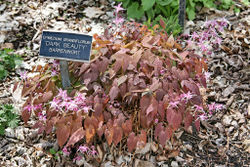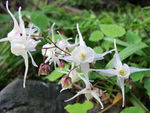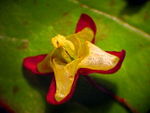Barrenwort
| Barrenwort |
|---|

|
| Scientific Classification |
|
| Species |
|
| leaves of barrenwort |
Barrenworts are species of flowering plants in the taxonomic genus Epimedium, which are also known by the common names Yin Yang Huo, Bishop's hat, Fairy Wings, and Horny Goat Weeds. The plants are perhaps best known as a Chinese medicinal plant with claimed aphrodisiac effects. [3] Usually leaves of the plant are used to make medicine and other parts are sometimes used. Epimedium's leaves are first used in China. About 15 leaves of the plant are used to make yin yang huo (Chinese: 淫羊藿), which is a Chinese traditional medicine. There is a lack of well-discovered studies of this plant. The herb has been studied for possible benefits in clogged arteries, menopause, and sexual disorders. More research is needed to determine its safety and effectiveness. [4]
Those flowers of Barrenwort contain icariin, which is a natural compound that increases blood flow to sexual organs and promotes sex drive. Extracts of the plant are also sold on online. They are sold in several ways such as teas, capsules, bulk powders and liquid tinctures. [5]
Body Design
Barrenwort's plant type is Herbaceous, which means that the stems are soft or succulent and green, as opposed to brown and woody. It is native to Bulgaria, Turkey, Caucasus, but it is usually found in China and Korea. Barrenworts grow up to 1.00 to 2.00 feet and spreading range is 1.00 to 2.00 feet as well. They spread by underground stems called rhizomes and flowers that usually bloom in from April to June. The flowers can be solid, bicolored, or a combination of several colors. Their flowers are yellow with pink to white inner sepals. [6]
The leaves are made up of leaflets. They can range in number from 3 to 50 and in size from as tiny as a sparrow’s egg to 6 inches long. They are generally heart-shaped, but can range from round to arrow-shaped. In summers, barrenworts that are sited in direct sun require abundant moisture, or the leaves would get burned. In southern gardens, barrenworts are best kept in the shade.[7]
Life Cycle
Barrenworts are long lived plants which are perennial. They grow from underground rhizome. There are many ways that it grows. Some of them have solitary stems, others have a "tufted" habit, with multiple stems growing close together. There may be several leaves to a stem or the leaves may be solitary, produced from the base of the plant. Individual leaves are generally compound, often with three leaflets, but also with more. Leaflets usually have spiny margins. The leaves are almost annual, making the plant deciduous, or longer lasting. Therefore the plants are evergreen. The inflorescence is an open raceme or panicle, the number of flowers varying by species. [8]
Ecology
Barrenworts are usually found growing all over the southern areas of China, but can also be found in the Asian countries that immediately border China, as well as some neighboring European countries. [9] Those are the places where they're naturally mulched by fallen leaves. In gardens, they thrive in well-drained yet moist, fertile soil, in dappled shade or morning sun.Strong afternoon sun will most likely burn their leaves, and summer drought or strong winds will burn their rhizomes. Therefore it is better to grow in deep shade. In spring, Barrenwort plants will benefit from some slow-release fertilizer, followed by a generous layer of mulch over the rhizomes.[10]
How To Grow
Barrenworts are members of the barberry family (Berberidaceae). Unlike other many perennials, barrenworts can last for decades with minimal care. When growing in deep shade, either in the wild or in the garden, plants are generally taller, have larger leaflets, and are slower to form large clumps than are those in dappled shade. They also have fewer flower stems per plant. So if a barrenwort that grow with sunshine will generally be shoter and have less leaflet than ones that grow in deep shade. [11]
5 Benefits of The Plants' Extract
Barrenwort's extract is used for taking care of people's health.
- Aphrodisiac: The icariin found in epimedium works by relaxing muscles by increasing the nitric oxide levels and increasing the blood flow to the sexual organs.
- Controlling Asthma: The study of Epimedium of China can be helpful in alleviating airway inflammation by decreasing the activities of some proteins that are responsible for the production of leukocytes in inflammatory areas in the lung.
- Body Building and Sports: The icariin found in epimedium is helpful and potent supplement in body building and sports.
- Memory Enhancer: The studies of barrenwort have shown us icariin helps us enhance memory system. The effect is mainly attributed to the plant’s antioxidant properties and its effect on the nerve impulses as well as the circulatory system.
- Cancer: The studies of barrenwort have been proven to be effective in decreasing the ability of invasion of cancer cells as well as the migration of the metastatic cancer cells. [12]
Video
Epimedium barrenwort
References
- ↑ Unknown Author Epimedium USDA Web. May 11, 2017
- ↑ Unknown Author sagittatum Wikispecies Web. May 19, 2017
- ↑ Moore, Shelley. what is Epimedium sagittatum? LIVESTRONG.com. Web. August 12, 2010.
- ↑ unknown Author. goat weed(Epimedium spp.) Wild By Nature Web. May 9, 2017.
- ↑ Nootriment Editorial Staff. Extract Benefits, Uses and Side EffectsNootriment Web. May 9,2017
- ↑ Unknown Author. pubigerum Missouri Botanical Garden Web. May 10, 2017
- ↑ Probst. Darrell Up-and-Coming Epimediums fine Gardening web. May 18,2017
- ↑ Unknown Author. [1] Wikipedia Web. May 21, 2017
- ↑ Unknown Author Goats Weed Herbwisdom.com Web. May 20, 2017
- ↑ Barbara Blossom Ashmun Epimedium—Foliage and Flowers of Subtle, Sophisticated Beauty Brooklyn Botanic Garden Web. March 1, 2007
- ↑ Probst. Darrell Epimediums fine Gardening web. May 18, 2017
- ↑ Chan. Anna Benefits of Epimedium Extract NATURAL HORNY GOAT WEED web. August 16,2016



